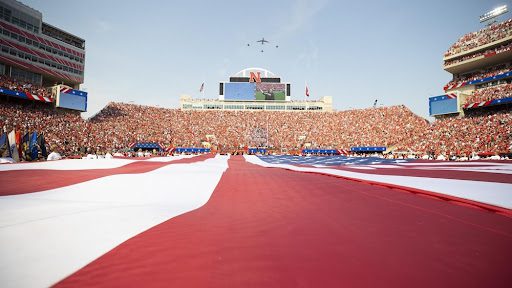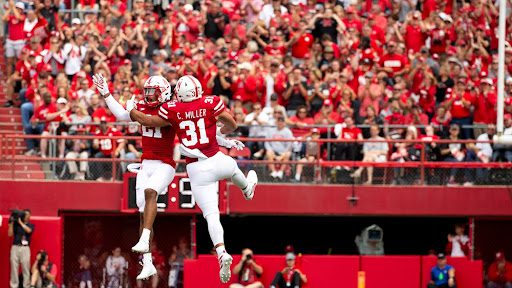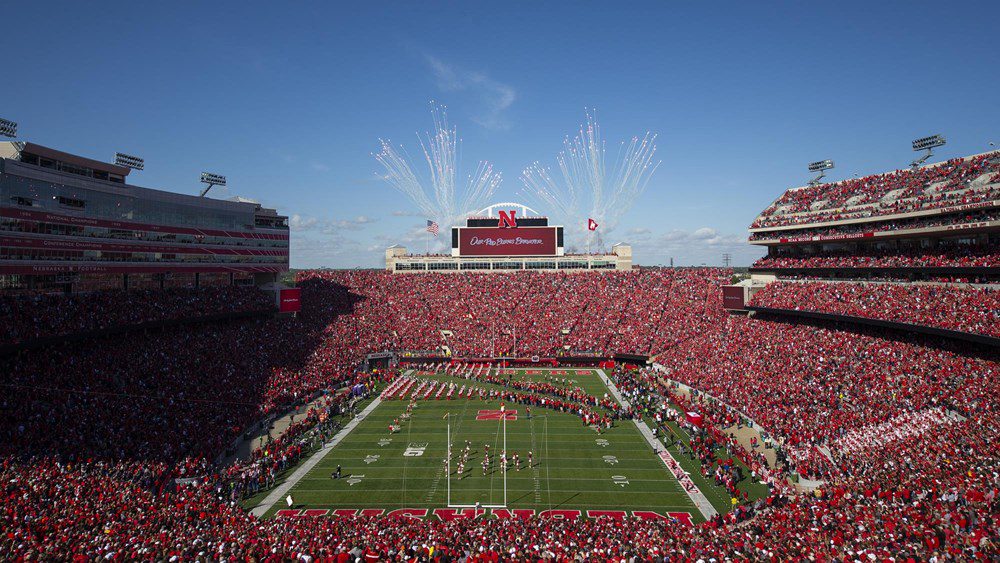Known as one of the “Cathedrals of College Football,” the University of Nebraska’s Memorial Stadium has sold out 382 consecutive Cornhuskers games, stretching from November 1962 through the 2021 football seasons. That’s an impressive feat considering the stadium’s capacity is over 85,000.
Having thousands of Big Red fans fill the stands each season creates a lot of trash. Happily, the University of Nebraska-Lincoln’s Athletic Department has a big sustainable streak, with 2009 representing a pivotal year for the stadium’s environmental programs. Nebraska Athletics teamed up with Recycling Enterprises and Pepsi to create an extensive trash collection system. Recycling bins stand in high-trafficked locations around Memorial Stadium, both inside and outside. Recyclable materials get separated, preventing waste from winding up in landfills. Additionally, Recycling Enterprises donates revenue back to organizers, which helps to support the recycling programs.

To help get students engaged with this recycling movement, the “Go Green for Big Red” organization was established on the UN-Lincoln campus. “Go Green” volunteers circulated through the packed parking lots distributing green recycling bags to tailgaters and later picking up the bags once the game began. Besides their vital hands-on work, these volunteers also have helped spread the word about recycling. “The more volunteers we get, the more we’re able to have those conversations with people,” Colton Berck, a UNL recycling coordinator, explained to the Daily Nebraskan. “There really is no better way of communicating how to do this and why we should be doing this.”
Success came quickly to Nebraska’s recycling mission. In the Environmental Protection Agency’s 2011 Game Day Challenge, the Cornhuskers recycled 6,880 pounds of waste, which placed them second in Diversion Rate and Waste Minimization within their Big Ten Conference and eighth overall in Waste Minimization and 24th in Diversion Rate. By 2013, Nebraska’s rate reached over 70% for the entire football season, which meant 50 tons of waste was diverted from landfills.
Contributing to this notable improvement was Memorial Stadium concession stands’ change to using more sustainable products, from recyclable serving ware, cups, and napkins to popcorn, candy, pizza boxes, and cardboard carry trays. The post-game pickup crews also played a crucial role, which made sure that discarded items (such as paper bags, cellophane wrappers, and Styrofoam containers) were collected and disposed of properly. The Athletic Department has been involved in other eco-positive programs, such as the free bike valet service that promotes carbon-free transportation to Memorial Stadium.
Traditions are a huge part of Huskers football games. Herbie Husker has been an official mascot at games since 1974, with Lil’ Red joining in on the fun in 1993. Both mascots have lent a big hand in the recycling mission, returning to the 2010 Game Day Challenge.
Another Nebraska tradition, the release of balloons after each Cornhusker touchdown, has been criticized because balloons contribute to waste and are harmful to the environment. However, the latex balloons used by Nebraska are said to be 100% biodegradable. In recent years, The Association of Students of the University of Nebraska (ASUN) and Sustain UNL have teamed up to raise awareness about this balloon tradition and to look for alternatives. In December 2021, the ASUN unanimously passed a resolution to stop the balloon release. The resolution, however, isn’t binding, so it can’t be enforced, but the resolution does signal that there is growing interest in reforming this stadium ritual.

A lot of attention is paid to Memorial Stadium, which is understandable since Cornhuskers’ football games attract the biggest crowds and create the biggest amount of waste at Nebraska; a football game typically results in around 20 times more trash than a soccer game. The Athletic Department expanded its sustainability efforts by placing recycling bins in other sports facilities. It also focused on recycling cardboard, containers, scrap metal, and wood pallets. Nearly $500,000 in furniture got repurposed instead of thrown away. Water-conserving measures included upgrading sprinkler heads and establishing maintenance programs that routinely check faucets and plumbing for leaks. Installing energy-efficient light bulbs and other electric appliances decreased electricity usage, which resulted in cutting costs and lowering carbon emissions. A shift to using more sustainable cleaning products and environmentally-thoughtful custodial equipment and procedures led to Nebraska becoming the first Big Ten university that was awarded a Cleaning Industry Management Green Building With Honors certification.
When the new basketball facility, Pinnacle Bank Arena, was constructed, eco-friendly materials were used. Features included energy-efficient plumbing, heating, and electrical systems. The arena uses 35% less energy compared to a traditional, similarly-sized building. It also received a $150,000 grant from the Nebraska Environmental Trust to support a recycling program, which includes recycling stations, disposal equipment, and educational outreach.
In 2018, a long-overdue overhaul of Memorial Stadium’s lighting system replaced nearly 20-year-old fixtures with a state-of-the-art system that operated on quieter and cooler levels and created a major reduction in energy usage. This upgrade made Nebraska one of the few Power Five schools and NFL teams with such an LED lighting system.
The Athletic Departments’ efforts have contributed to the university’s overall improvement in sustainability. In 2019, UNL could conserve nearly a million pounds of air pollution, over 2,800,000 kW Hours of Electricity, approximately 2,300 cu. yard of landfill space and achieve a diversion from landfill rate of 59%.





